Porcellio scaber - is a terrestrial isopod, one of the most common representatives of woodlice in Europe and other parts of the world. It can be found almost anywhere there is moisture, shade, and organic matter.

📚 Classification
• The Kingdom: Animalia
• Type: Arthropoda
• Class: Crustacea
• Row: Isopods (Isopoda)
• Family: Porcellionidae
• Gender: Porcellio
• View: Porcellio scaber Latreille, 1804
🔍 Appearance
📏 Sizes
- Adults reach 1-1.8 cm in length
🎨 Description
- Body oval, segmented, with 7 pairs of legs
- Color: gray, brown, black, sometimes with spots
- The surface is rough - hence the name scaber (Latin for "rough")
- Large faceted eyes, medium-length antennae
- It does not curl into a ball, unlike some woodlice (e.g, Armadillidium)
🌍 Habitat and environment
📌 Spread
- Almost all of Europe
- Imported to North America, South America, Asia, Australia
🏡 Places of residence
- Moist places: under stones, in forest litter, under bark, in cracks
- Often near people's homes - in basements, greenhouses, gardens

🧠 Behavior
🌙 Activity
- Nocturnal creature - hides in moist shelters during the day
- In case of danger, she runs away quickly, but not as fast as Ligia oceanica
👥 Sociality
- Often found in large groups
- Conflict-free, non-aggressive
🍽️ Power
• Saprophyte - consumes dead plants and animals
- Nutrition:
- with fallen leaves
- rot
- mushrooms
- dead insects
- mold - Sometimes eats young shoots of plants in greenhouses, but rarely
🧬 Reproduction
- Bisexual
- Female lays eggs in a special brood chamber under the abdomen
- The young are fully formed, undergo several molts
📅 Life cycle
- Life expectancy: 1.5-2 years
- Reaches sexual maturity in a few months

🧾 Interesting facts
✔️ Breathes with gillswhich must be moistened - that's why woodlice are so sensitive to dry air
✔️ Bioindicator: responds well to soil and air pollution
✔️ Not a parasite and not dangerous to humans
✔️ Often used in bioaquariums and terrariums as part of a "living substrate" - helps to utilize organic residues
✔️ It is studied as model organism in science to study aging, regeneration and adaptation to stress
🏡 Keeping in captivity
🪴 Often bred in terrariums as "orderlies"
They do:
- Substrate: coconut soil, leaves, wood
- Constant humidity 80-90%
- Food - vegetables, leaves, fish food
- Temperature: 18-25°C
- Coexist well with many other species (snails, tropical frogs)
🤝 Comparison with others
| View | Size | Colour | Living environment | Feature |
|---|---|---|---|---|
| Porcellio scaber | ~1.5 cm | Gray | Wet ground, garden | Rough surface, does not roll up |
| Armadillidium vulgare | ~1.5 cm | Gray-black | Also land-based | Rolls up into a ball |
| Ligia oceanica | ~3 cm | Metallic gray | Coastal cliffs | Runs fast, lives by the sea |
Conclusion
Porcellio scaber - is a small but extremely important creature that helps keep the environment clean. It is not only interesting to observe in nature, but also useful for scientific and decorative purposes. Due to its adaptability, this "common woodlouse" has become a global traveler and an indispensable assistant in ecosystems.